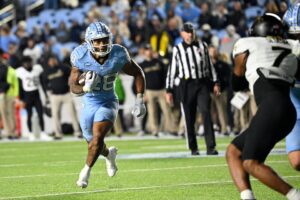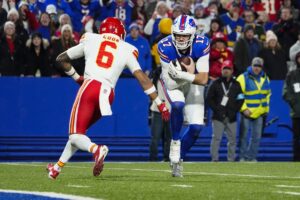In Las Vegas, and in gambling at large, there is the notion to insistently go all in, play wild, and risk everything. Hence, walking into a casino while not adhering to any model of a plan hoping luck is in the air. In a wild division game where the Kansas City Chiefs need a win to secure the AFC West, the temptations exists for the Chiefs to play to with that philosophy – passing wildly to Tyreek Hill and Travis Kelce while dialing zero blitzes to disrupt Philip Rivers at will. However, that is a plan for nothing but true chaos, even if explosive plays are more fun. As seen in the win over the Oakland Raiders, adhering to a boring plan is still a viable strategy. To truly make money in Vegas, one quietly counts cards, plays the numbers with exquisite precision, and exits stage left while they are still ahead. The Kansas City Chiefs week 15 scheme must adhere to principles of traditional success that are precisely planned and executed to take away that which has made the Los Angeles Chargers successful.
Kansas City Chiefs Week 15 Scheme Breakdown – Playing Their Own Game
Repeating Success
In week three, the Chiefs were still hot, thriving, and had mentality and momentum on their side. The Chargers were completely at a loss, finding ways to lose in the closing moments of a game. 12 weeks later, those notions are completely reversed. The Chiefs are walking into the casino with their last dollar, putting their hope for success on the black jack table. The Chargers are the house, with the control and advantage of numbers.
Thus, the Chiefs need to return to playing their own game of fundamentally charging the football to Kareem Hunt on counter and power run sets. That underlying tenant may not be flashy, but that strategy ended the Chargers will in the second half of the first game. Hunt did not realize wild success throughout the game, but constant churning eventually created a 172-yard performance, with an explosive 69-yard run to ice hope.
The Chargers are a defense which plays with exquisite ferocity. Between Joey Bosa and Melvin Ingram, the defense has 21.5 sacks, with a litany of other plays coming to raise the total to 37 sacks. Their front seven is tied intrinsically to the entire success of the defense. Hence, running the ball to glory will put the strategy in the Chiefs hand to assert, not Andy Reid attempting to solve how the Chiefs will work around the Chargers.
The Chargers have improved defending the run, but still intrinsically struggle due to their set of linebackers. Ingram is more poised as a finesse pass rusher than a true run-stopper, and the same could be said of Bosa. The reliance goes onto defensive tackles Darius Philon and Corey Liuget to put pressure in the middle, and open lanes for linebacker Jatavis Brown for run-to-fit.
Brown is good, but not spectacular. A fully healthy Chiefs offensive line will be able to utilize pulling guards to push through the interior and pin linebackers away from the play. There is a semblance of intelligence needed from the line, however. The front seven will flip-flop in looks due to the focus on creative blitz packages and multiple alignment appearances.
While the pass game will not be as spectacular, efficiency wins at the end of the game. Alex Smith went 16 for 21 and a mere 155 yards on his way to beat the Chargers in week three. Again, simplicity in plan and playing to their own comfort removes the need for Smith to become Peyton Manning and outwit a defense.
Tre Boston in the middle of the field will most likely remove deep routes in that sector. In other words, Kelce will be a primary decoy for route concepts. Offensive coordinator now play-caller Matt Nagy has used more isolation for Hill while building slightly deeper routes for the likes of Albert Wilson.
The Chargers rely on man-to-man coverage on the outside. One primary play format that may work is unleashing Kelce down the middle of the field, aligned opposite from Hill, which places Hill one-on-one with Casey Hayward or Jason Verrett away from strength. As improved as corner play has been, the physics of speed simply dictate Hill will out run them. If the offensive line protects Smith, a precisely timed route to Hill early in the game should not come as a surprise.
Alas, the more safe, managerial Smith will win out at the end of the day. Running simple routes to Hill instead will allow his speed to impress even in short routes. Isolation can come on short dig routes as well – isolation is not intrinsic to deep bombs. Furthermore, Wilson will take the simple under routes, but must do so with precise technical procedure.
The Chargers may keep everything in front of them, but adding together a five-yard pass, a three-yard run, a ten-yard pass, a two-yard run, a six-yard run implicates long, drawn out drives that keep the game plan in the Chiefs hands.
Stop the Flow of the River
Part of the frustration with the Chiefs is the entire aforementioned offensive strategy is built on sustaining drives in their own comfort. And to sustain drives with comfort, the Chiefs need to have either the lead, or the essence of a very close game. The Chiefs defense has habitually made that a difficult task, less they begin sacking the quarterback.
The central tenant of the Chargers wild ride from the bottom of the division to competing for the AFC West title has been Rivers utilizing a bevy of weapons to attack the exterior and deep parts of the field. The most prominent weapons are Keenan Allen and Travis Benjamin, two burning wide receivers who have the potential to embarrass the Chiefs secondary.
Combined with power tight end sets, the Chargers utilize multiple formations to misalign defenses, exposing the opposition’s weak coverage assets. Allen becoming a deep threat has drawn safeties away from the line of scrimmage, allowing running backs Melvin Gordon and Austin Ekeler to scuttle down around the field for quaint, third-down conversions.
The running game has not been prominently successful for the Chargers, but Gordon can timely execute runs to give the Chargers advantage in the middle of the field. The one area the run still falters in the red zone. Gordon is a tremendous finesse runner, but has trouble switching to power run concepts when called upon.
Hence, in the red zone, defenses can bear down on the outside zone and stop the aerial assault with more confidence. The onus is put on tight ends Hunter Henry and Antonio Gates to finish red zone assaults, and if safeties or linebackers can jam them at the line of scrimmage or blitz Rivers, everything falls apart and results in a field goal.
And that is exactly where the Chiefs defensive attack must begin – jamming, physicality, and delaying timed plays. Rivers is a quarterback, pun intended to his name, who relies on the flow of a game to ferociously succeed. The Chiefs corners had tangential success against under routes by asserting a dominant physicality against Michael Crabtree. Although Allen is a more refined receiver in the technical aspects of deep, post routes, the same concept ought to work as jamming intrinsically disrupts the timing of a play.
Darrelle Revis has shown his age, but delaying precision timing routes while in exterior coverage will give Ron Parker time to jump and offer assistance from his zone. Relying on such a zone does implicate Parker cheating upwards, which puts a heavy emphasis on the Chiefs corners not allowing anything to get behind them.
Marcus Peters will be back this week after a one-game suspension for disorderly conduct. Hopefully the suspension served the intended purpose and Peters will return with a focused mentality, ready to take on Allen. That puts Revis on Benjamin. However, assistance and switching on and off would not be unnatural or a poor fit.
But ultimately every tenant in the defensive scheme falls to mere dreams if the pass rush is boring. Not only must Justin Houston create pressure, but seeing a continued presence from Jarvis Jenkins and Chris Jones in interior gaps would force Rivers to focus on shifting coverage. Any play that removes flow from Rivers is a play in advantage of the Chiefs defense.
The running attack from the Chargers may not be the most prominent or special feature, but again Gordon can dash in the middle of the field. There is nothing new or fancy about run-to-fit concepts, but Reggie Ragland and Derrick Johnson ought to take the foremost responsibility. If Daniel Sorensen or Parker end up making most of the run tackles, the Chiefs are in trouble.
Last week, the Raiders were seen attempting to run swing passes to send the flow of the play to the exterior, short-side of the field. Johnson smashed these plays, and ended any extension of the run. Ekeler has become the swing for the Chargers, and much of the same intensity from Johnson should take away a primary strong suite.
Summarizing the Plan of Attack
The offense will be tempted to come out, chucking the ball erratically, and reliant on explosive plays to win. However, relying on routes that must develop plays into the hands of the Chargers pass rush removes Smith from where he is best. Smith is an excellent manager, and wins confidently when allowed to operate in such a way. Thus, the entire game plan must begin with Hunt insistently running with an intermix of Hill in isolation routes. Without those two tenants, the Chiefs will be spending their afternoon punting.
The Chiefs defense must take away the flow of the game from Rivers by disrupting with pressure and jamming receivers. Erasing confidence and planning will assist a troubled secondary, and force the Chargers to over rely on their deep, timing routes. Proper run-to-fit and pure intensity from the interior linebackers will play a prominent role in slowly making the Chargers more one-dimensional.
Main Image:






